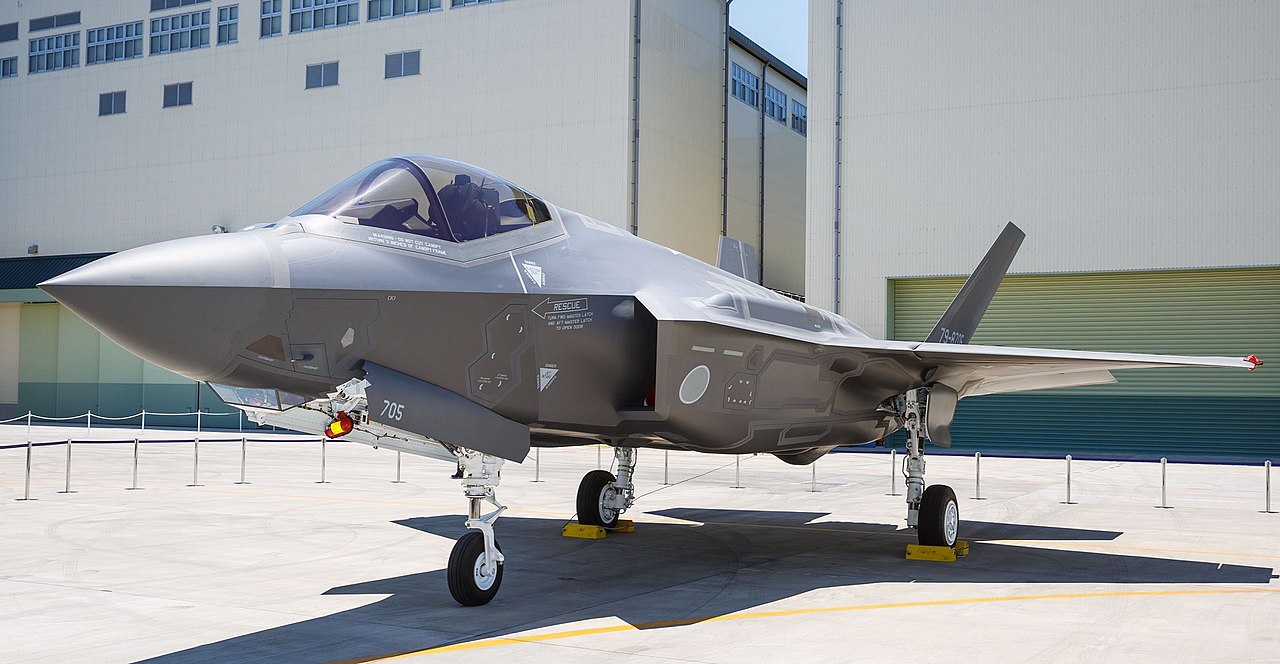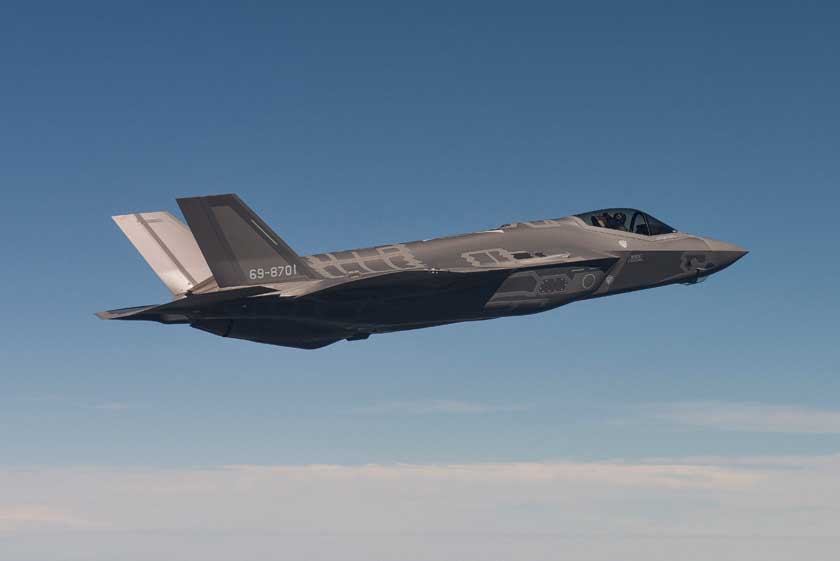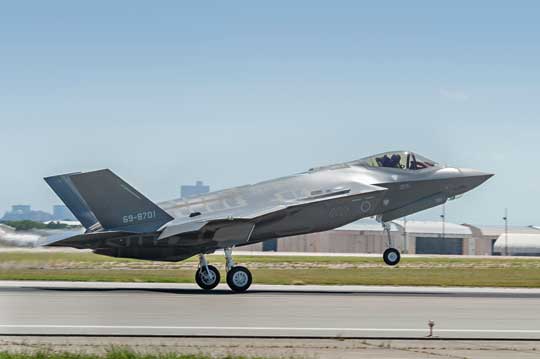
Lockheed Martin F-35 Lightning II in Japan

The first Japanese F-35A (AX-01; 701) in flight on August 24, 2016. The Japanese government approved the purchase of 42 F-35As on December 20, 2011, and signed an intergovernmental agreement on June 29, 2012.
Japan has been among the growing users of the F-35 Lightning II multirole combat aircraft for several years now. It is also the second country after Italy (not counting the USA) in which the F-35 assembly and service center operates. Unlike much of the rest of the world, where the F-35 will be the primary combat aircraft for the next few decades, in Japan it is considered an important but complementary addition to two other types - the redesigned F-15J/DJ kai and the new next-generation FX fighters.
In the middle of the first decade of the 2nd century, the Japan Air Self-Defense Force (Kōkū Jieitai; Air Self-Defense Force, ASDF) faced the question of choosing new combat aircraft. For financial reasons, the production of Mitsubishi F-2008A/B strike fighters was limited, and in 4, it is planned to begin recalling the McDonnell Douglas F-15EJ and Phantom II fighters. Although the avionics of the McDonnell Douglas F-5J/DJ Eagle interceptors were modernized (see box), with the construction of the 20th generation fighters (Chengdu J-50 and Sukhoi T-5/PAK FA, respectively), the ASDF was in an unfavorable situation. The Japanese were very interested in the 22nd generation American fighter Lockheed Martin F-XNUMXA Raptor, but due to an export ban passed by the US Congress, their purchase was not possible. Therefore, they initiated their own research and development program for a new generation of fighters (see box).

The first Japanese F-35A makes its maiden flight from Fort Worth, Texas; August 24, 2016 In the cockpit of a Lockheed Martin test pilot,
Paul Hattendorf.
Medium Term Defense Program (MTDP) for Fiscal Years 2005-2009, based on the National Defense Program Guidelines adopted by the Government of Japan on December 10, 2004 (Bōei Keikaku no Taikō; National Defense Program Guidelines, NDPG) for 2005 and subsequent financial years noted: The Government of Japan will promote the modernization of the F-15 fighter and purchase new fighters to replace the F-4. However, a change in government meant that the adoption of specific decisions on the purchase of the successor to the F-4EJ kai was delayed for several years. Only in the next SPR for 2011-2015, based on the NPD 17 and beyond, adopted by the government on December 2010, 2011, it was planned to purchase the first batch of 12 new tactical fighters.
Candidates being considered include: Boeing F/A-18E/F Super Hornet, Boeing F-15 Eagle, Lockheed Martin F-35 Lightning II, Dassault Rafale and Eurofighter Typhoon. In December 2008, this list was narrowed down to the F-15, F-35 and Typhoon. ASDF representatives visited each of the factories to learn about aircraft performance and production methods. Among other things, on this basis, in June 2010, the F-15 was replaced by the previously rejected F / A-18E / F. In the meantime, the government decided to add to the list of requirements the possibility of licensed production or final assembly of purchased aircraft in Japan. The idea was to keep jobs in the Japanese aviation industry, especially Mitsubishi Heavy Industries (MHI), which had spare production capacity after the F-2's early termination and did not want to lay off its experienced, highly trained technical staff.
On April 13, 2011, the Japanese Ministry of Defense (Bōeishō) sent formal Requests for Information (RFIs) on the new fighters to the US and UK governments. The deadline for submitting proposals was 26 September. After their analysis, on December 20, 2011, the Japanese government and the National Security Council (Kokka Anzen Hoshō Kaigi; National Security Council) approved the selection of the F-35A. The decisive factors were: multitasking, especially the very high capabilities in air-to-ground missions, the technical excellence of the aircraft and the prospects for further development in the future, as well as admission to the final assembly and production of selected parts and assemblies in Japan. Although the F-35 development and testing program was plagued by numerous technical problems and lengthy delays at the time, the Japanese planned to purchase 42 units starting in fiscal year 2012.
Following the announcement of the Japanese government's decision, Lockheed Chairman and CEO Martin Bob Stevens said, “We are proud of the trust the Japanese government has placed in the F-35 and our production team to bring this fifth generation fighter to Japan. Air Self Defense Force. This announcement marks a new chapter in our longstanding partnership with Japanese industry and builds on the close security cooperation between the US and Japan.
Conclusion of the contract
On April 30, 2012, the Defense and Security Cooperation Agency (DSCA) informed the US Congress that the Japanese authorities have applied to the US administration for permission to sell four F-35As under the FMS (Foreign Military Sale) procedure with the possibility of another 38 The total maximum contract value, in addition to the aircraft itself, which also includes additional equipment, spare parts, technical documentation, tools, personnel training and operational support, was estimated at $10 billion. In support of the request, the DSCA stated: Japan is a major political and economic power in East Asia and the Western Pacific and a key US ally in bringing peace and stability to the region. The US government uses bases and facilities in Japan. The proposed sale is in line with US political objectives and the 1960 Treaty of Mutual Cooperation and Security.
A formal intergovernmental agreement (LOA) for the purchase of four F-35As with an option for 38 (which were used in subsequent years) with equipment and related services was signed on June 29, 2012. On this basis, the US Department of Defense, acting on behalf of the Government of Japan, on March 25 2013 signed a corresponding contract with Lockheed Martin. The US Department of Defense's January 2013 annual report states that the first four F-35As of the ASDF will have Block 3i avionics software. Subsequent machines from the Lot 9 LRIP (Low Rate Initial Production) series are already equipped with the Block 3F software.